Buffalo
Buffaloes are heavy, cow-like animals. They are recognized from afar by their wide or curved horns and solid bodies with black coats. People often mix up the terms bison and buffalo. Although they bear some resemblance, they are not the same.
Bison and buffalo belong to two different genera of the Bovine family. They are distinguished based on their horns and geographical locations. Buffaloes have wide horns and live on the continents of Africa and Asia, while bison have comparatively shorter horns and are found in America and Europe.
Scientific Classification of Buffalo
Kingdom | Animalia |
Phylum | Chordata |
Class | Mammalia |
Order | Artiodactyla |
Family | Bovidae |
Different Species of Buffalo
Three species of buffalo fall into the two genera; one is Syncerus, and the other is Bubalus. Further subspecies lie in these species.
African Buffalo (Syncerus caffer)
African buffalo is one of the five big safari animals of Africa, along with elephants, rhinoceros, lions, and leopards. They are further divided into four subspecies.
- Forest buffalo
- West African Savannah buffalo
- Central African buffalo
- Cape buffalo
Water Buffalo (Bubalus bubalis)
Water buffalo, also known as Asian buffalo, is the largest of the three species. They are further divided into two subspecies.
- River buffalo
- Swamp buffalo
Anoa
Anoa is the third type of buffalo and it is the smallest among them all. It has two recognized species.
- Lowland anoa
- Mountain anoa
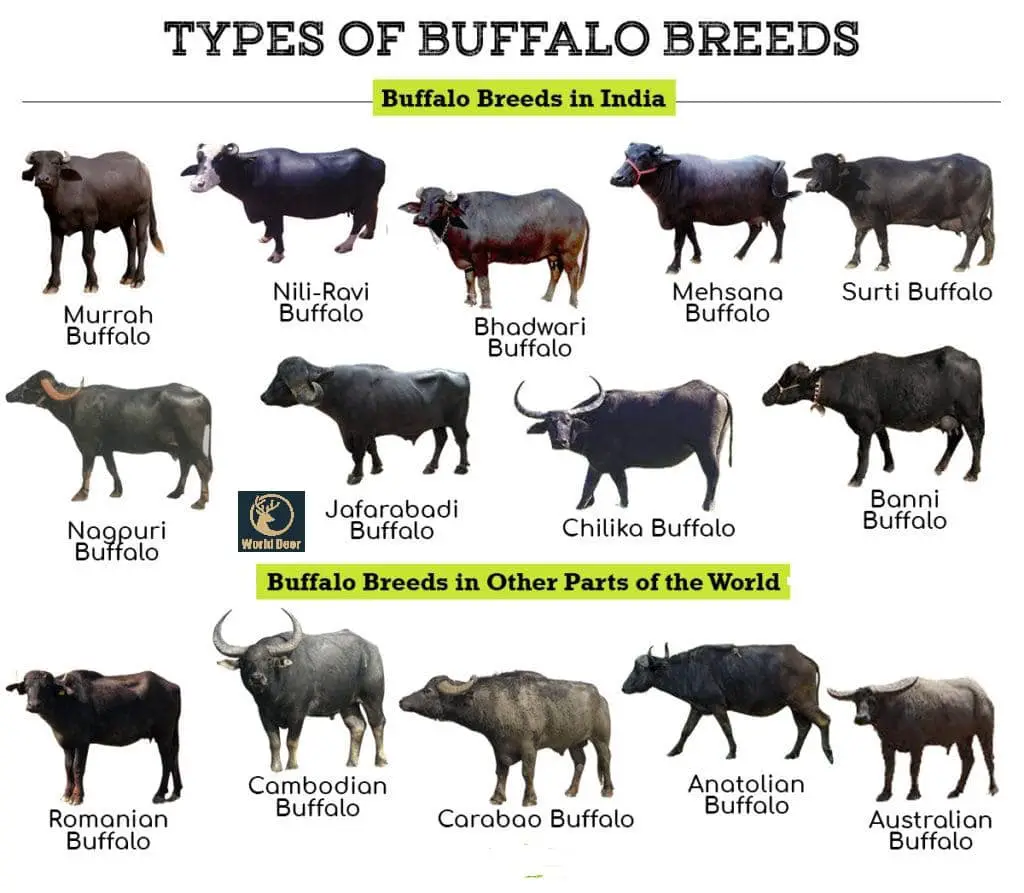
Physical Characteristics
Size and Weight: Size varies within the species. African buffaloes are 4.2 to 4.9 feet in height and weigh between 425 to 870 kilograms. Asian buffaloes stand 5 to 6.2 feet tall at the shoulder and weigh up to 1200 kilograms. Females are smaller than males, weighing 800 kilograms. Anoas are just 3 feet tall at the shoulder and weigh only 130 to 150 kilograms.
Speed: They can run up to 60 kilometers per hour (37 miles per hour).
Head and Horns: African buffaloes have thick and broad horns, 100 centimeters (3.9 feet) long, which cover their head like a helmet. Asian buffaloes have curved and crescent-shaped horns, 150 centimeters (4.9 feet) long. Anoa have straight and smaller horns compared to other buffaloes.
Legs and Tails: They have stout and sturdy legs that support their massive body. The tail adds some extra weight and length to the body.
Body and Coat Coloration: They have a solid body covered with a coat of sparse hairs. Coat coloration varies between black, gray, and brown.
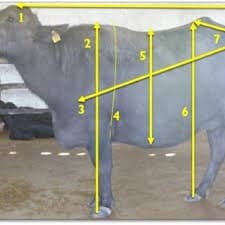
Buffalo Height
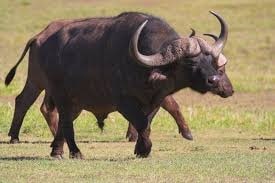
Buffalo Speed
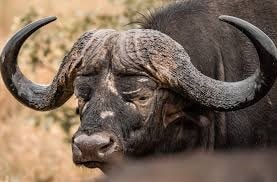
Head and Horns
Distribution and Habitat
Buffalos tend to live in various grassland habitats, which may be open, bushed, wooded, forested, and swampy. African buffalos are found in sub-Saharan Africa. They inhabit open savannahs, rainforests, and semi-arid bushlands where there is a permanent source of water.
Asian buffalos are primarily distributed in India, Nepal, Bhutan, and a wildlife reserve in Thailand. They tend to live in swamps and forests. Anoa, the smallest type of buffalo, is found in the swamps of the Indonesian islands of Sulawesi and Buton.
Diet and Digestion
Buffaloes are natural grazers. They primarily feed on grass, hay, leaves, weeds, herbs, and shrubs. They are green feeders and spend most of their time grazing and feeding. They also eat legumes and other vegetables. After grazing, they typically spend half of their time chewing their cud to extract more nutrients from their food. They also consume insects, bird nests, and eggs when these are found on the ground.
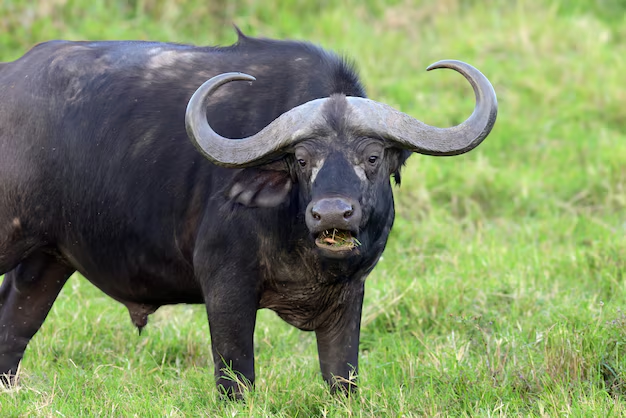
Behavioral adaptations
Foraging Behavior
Buffaloes forage during the early morning, evening, and night. The foraging period lasts 9 to 11 hours a day. They spend their daytime in shady areas and live near water sources so they can wet their throats after eating dried grass.
Social Behavior
A group of buffaloes is called a herd. A female buffalo is called a cow, while males are called bulls. Their offspring are called calves. Herds are typically segregated by gender. Cows form herds with their offspring, while bulls spend most of their time in bachelor groups, similar to elephants.
An African herd is the largest of all buffalo species. They mostly spend their time in large groups, typically ranging from 20 to 2,000 buffaloes. An Asian herd typically contains five to eight cows and their calves. It may reach up to 30 individuals, sometimes including bulls. The Anoa herd is the smallest, with just five buffaloes.
Defensive Behavior
When predators attack, buffaloes can run quickly at a speed of 37 miles per hour. Their horns serve as a defense tool, though they are not completely immune to predators. Typically, they form large groups to protect themselves from predators.
Muddy Adaptations
Asian buffaloes spend most of their daytime in the muddy waters of Asia’s tropical forests. Their coat color turns reddish-brown when they emerge from the mud. In Indian documentaries about buffaloes, you may see them bathing in rivers or relaxing in mud. This is another reason for their names: river and swamp buffalo.
Communication
African buffaloes are generally poor communicators. They mostly remain quiet but start vocalizing during the mating season with sounds like grunting, and bellow when a calf is in danger, prompting the herd to run to its defense. Asian buffaloes, on the other hand, are quite vocal and communicate with sounds such as grunting, bellowing, and snoring.
Reproduction and Parenting
Male buffaloes begin to breed at the age of 4 to 5 years, while females start breeding at just 2 years of age. The most dominant bulls may obtain most of the matings. They are polyestrous and capable of calving throughout the year, producing two calves every three years.
The gestation period lasts up to nine months. Typically, they give birth during the rainy seasons when the nutritional value of the grass is higher, which is advantageous for conceiving females. Calves depend on their mothers, suckling for as long as one year. Male buffaloes leave the herd when they are 4 to 5 years old, while female calves remain within the natal herd.
Mortality rate and Lifespan
On average, the mortality rate of buffalo calves is 30% to 40%. The average lifespan of a buffalo is ten to twenty years. In Asia, wild buffalo may live for twenty-five years, while domestic buffalo can live for up to forty years. In Africa, wild buffalo live for fifteen to twenty years, with their lifespan extending to thirty years in captivity.
Causes of Death:
- Predators: Buffalos are prey animals and are hunted by lions, spotted hyenas, leopards, and crocodiles. According to a report, they are also often killed by elephants.
- Diseases: Infections like anthrax, clostridial diseases, and parasites are sudden causes of death. Deaths can also occur due to heart or muscle damage.
Human Conflict
Hunters have dubbed them the ‘black death’ due to their dangerous appearance. They are also aggressive and unpredictable, known to break fences to raid cultivated crops and destroy them. Additionally, they spread bovine diseases among livestock. However, there was a recorded decline in the buffalo population during the 1890s epidemic.
Economic Importance
These guardians of grasslands play an important role in the agricultural economy of 4 continents, including Asia, Africa, Europe, and America. For more than 5000 thousand years, buffalo have fulfilled human needs with their milk, meat, horns, butterfat, and plowing crops. It is also used for transportation purposes. No other animal has economic significance like buffalo.
Dairy Production
Buffalos are lactating animals. Domestic water buffalo have a valued share in global milk production. About 70 percent of the world’s water buffalo population consists of the River buffalo. It is more lactating than its counterpart swamp buffalo species. India and Pakistan are the world’s largest water buffalo milk producers, with a percentage of 66.6 and 55.0, respectively.
Meat Production
India is the biggest shareholder in the buffalo meat market, while Pakistan is second and other countries, including Nepal, Bhutan, Egypt, Philippines, etc. About fifty percent of food needs depend on the buffalo meat in these countries.
Conservation Status and Efforts
According to the Red List of IUCN, African buffaloes are categorized as near threatened species, while Asian buffaloes are classified as endangered species. Anoa are also endangered, with a population of only 2500 individuals in both species.
Reason of the population decline is habitat loss, fragmentation, hybridization, and hunting. However, ongoing conservation efforts are helpful for the survival of these grazers.
Buff Fun Facts
- Buffalo are the giving animals.
- A matriarch leads the buffalo herd.
- They are inherently social animals with dozens of herds.
- Hunters called them the “black death”.
- They have a keen sense of smell.
- They are good hearers and have good night vision.
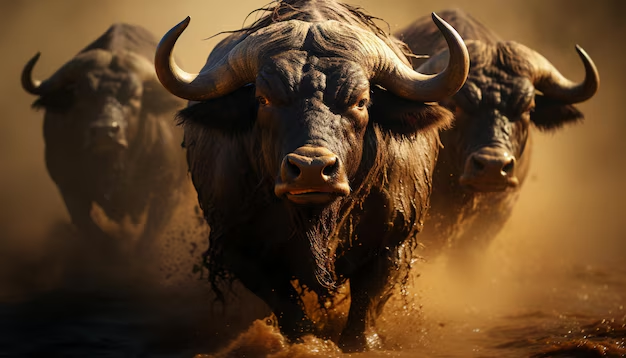
Cultural Value
- Buffalo symbolizes abundance, unity, and prosperity in many cultures.
- Indigenous people respect Buffalo because he respects the needs of others.
- Native Americans considered them as relatives. As they fulfill their survival with food, shelter, clothing, and other needs, they praise buffalo in their prayers, songs, and dances.
- They are also used in rituals.
Did you know the name of the 2nd largest city in New York state?
FAQs- Frequently Asked Questions
1- What are 5 facts about buffalo?
- Buffalo are large, herbivorous mammals.
- They are native to Africa and Asia.
- They have a social structure and live in herds.
- Buffalo have strong, curved horns.
- They are known for their resilience and strength.
2- What is a buffalo known for?
Buffalo are known for their strength, endurance, and ability to live in harsh conditions.
3- What do buffalos do all day?
Buffalo spend their day grazing, resting, and socializing within their herd.
4- What are the special features of buffalo?
Buffalo have strong, curved horns, a robust body, and thick hides that protect them from predators.
5- Is buffalo male or female?
Buffalo can be either male or female.
6- What do buffalo eat?
Buffalo primarily eat grasses and other vegetation.
7- How long do buffalo live?
Buffalo can live up to 20-25 years in the wild.
8- At what age do buffalo get pregnant?
Female buffalo typically reach reproductive age around 3 years old.
9- Is buffalo halal or haram?
Buffalo meat is considered halal if the animal is slaughtered according to Islamic guidelines.
10- Which country eats buffalo meat?
Countries like India, Nepal, and Indonesia consume buffalo meat.
11- Is buffalo a grassland animal?
Yes, buffalo are grassland animals.
12- What animal is the king of the grasslands?
The lion is often referred to as the king of the grasslands.
13- What is the most common animal in grasslands?
Grasslands commonly host animals like bison, antelope, and zebras.
14- How do buffalo survive in the grasslands?
Buffalo survive by grazing on grasses, using their strong horns for defense, and living in herds for protection.
15- Why is the buffalo so important?
Buffalo are important for their ecological role in grasslands and their cultural and economic significance to humans.
16- How did the buffalo survive?
Buffalo survive through their strong social structure, grazing habits, and adaptability to harsh environments.
17- How do buffalo sleep?
Buffalo typically sleep lying down but remain alert to potential threats.
18- How cold can buffalo survive?
Buffalo can survive in temperatures as low as -30°C (-22°F) with their thick hides and robust bodies.
19- What is buffalo’s behavior?
Buffalo are social animals that live in herds, graze throughout the day, and display protective behaviors towards their group.
Learn More About Buffalo
Welcome to our page dedicated to the intriguing ways buffalo behave. Here, you’ll find articles that answer common questions about buffalo, such as what they eat, when they’re most active, their reproductive cycle, and how they interact with humans in various environments.
Scroll down to learn more about the unique behaviors of buffalo and discover the reasons behind their actions.
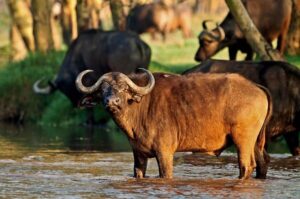
African Buffalo (Syncerus Caffer)
Introduction to African Buffalo The African Buffalo, scientifically known as Syncerus caffer, is one of the most iconic animals roaming
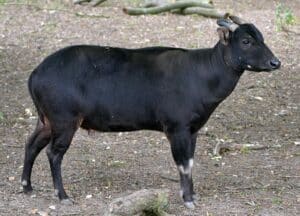
Anoa
Introduction to Anoa The Anoa is one of the most unique and fascinating members of the bovine family. As the

Forest Buffalo (Syncerus caffer nanus)
Introduction The Forest Buffalo (Syncerus caffer nanus) is a unique and fascinating animal, known as the smallest subspecies of the
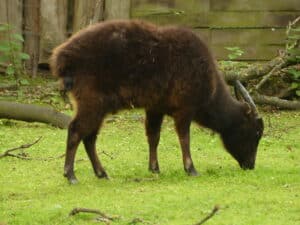
Mountain Anoa
Introduction to the Mountain Anoa The Mountain Anoa (Bubalus quarlesi) is one of the world’s smallest wild cattle species, native
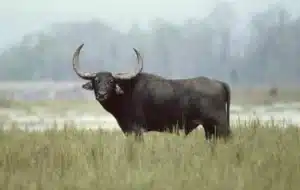
Swamp Buffalo
Introduction to the Swamp Buffalo The Swamp Buffalo (Bubalus bubalis), often referred to as the “living tractor of the East,”
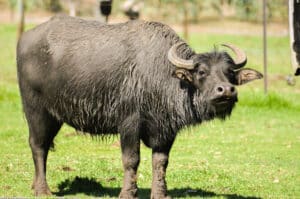
Water Buffalo (Bubalus bubalis)
Introduction The Water Buffalo, scientifically known as Bubalus bubalis, is a fascinating mammal that plays a vital role in both
